
Do-it-yourself "anti-rain" for car glass: purpose, recipes, step-by-step actions
Content
Each car owner tries to provide maximum comfort while driving, as well as reduce the time and money spent on servicing his car. However, the difficult weather conditions that are typical for spring and autumn, as well as the quality of the road surface, lead to rapid contamination of not only the body, but also the windows. To protect the glass surface and increase the level of comfort and safety, it is necessary to use a modern “anti-rain” agent.
What is the use of "anti-rain"
Recently, car owners are increasingly using such a tool as “anti-rain” for their cars. The substance is a chemical composition designed to be applied to the glass surface in order to remove precipitation under the influence of an oncoming air flow. "Anti-rain" is applied to the working surface of the glass, and after the evaporation of volatile compounds, a protective layer is formed that interacts with the glass. This polish fills microcracks, scratches and other defects. After that, it is enough for the car to pick up a certain speed during the rain, as the water under the air currents itself will fly off without interfering with the view. In this case, the wipers do not need to be turned on.
Video: how "anti-rain" works
What is "anti-rain" made of and what happens
The product contains polymer and silicone components contained in an organic solvent. "Anti-rain" is divided into several types:
- Liquid. The use of such products is quite simple and comes down to wetting the fabric and applying the substance to the surface. The quality largely depends on the means used (composition, manufacturer). The consumption of liquid polish will be large, since the container is not equipped with a dispenser.

 Liquid "anti-rain" is easy to use and high consumption
Liquid "anti-rain" is easy to use and high consumption - Special wipes. One of the expensive options for "anti-rain". The cost of napkins starts from 200 r. for a pack. The effect after surface treatment is good, but short-lived. It is best to use tissues as a fallback.

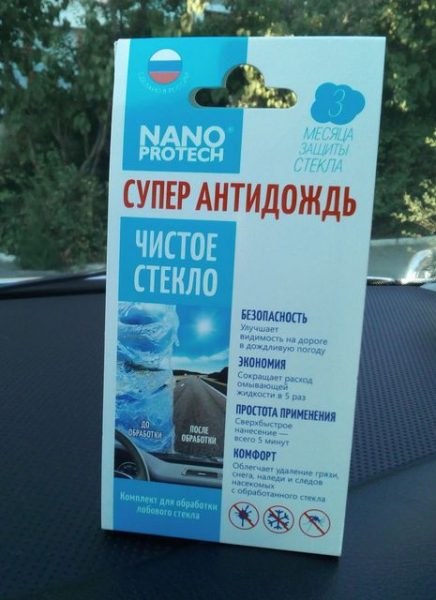 Napkins are an expensive option and are best used as a backup.
Napkins are an expensive option and are best used as a backup. - In ampoules. Such funds are the highest quality and most expensive, are labeled "nano". Duration of action is about 3-5 months. The cost starts from 450 rubles.

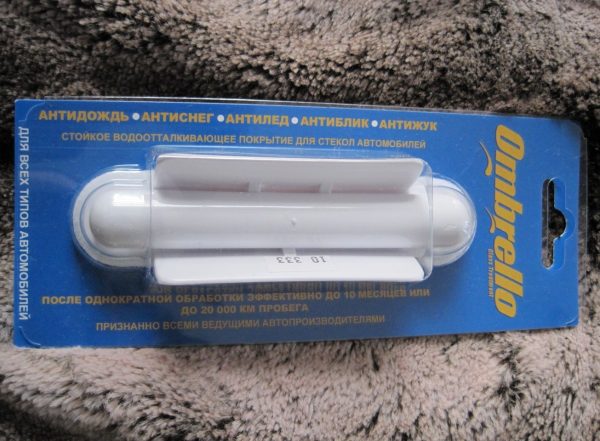 "Antirain" in ampoules is the most effective remedy and at the same time the most expensive
"Antirain" in ampoules is the most effective remedy and at the same time the most expensive - Spray. Refers to affordable and practical means. Sold in the form of aerosol cans. The consumption of the substance is small, since it is applied by spraying. The minimum price for the tool is 100–150 rubles.

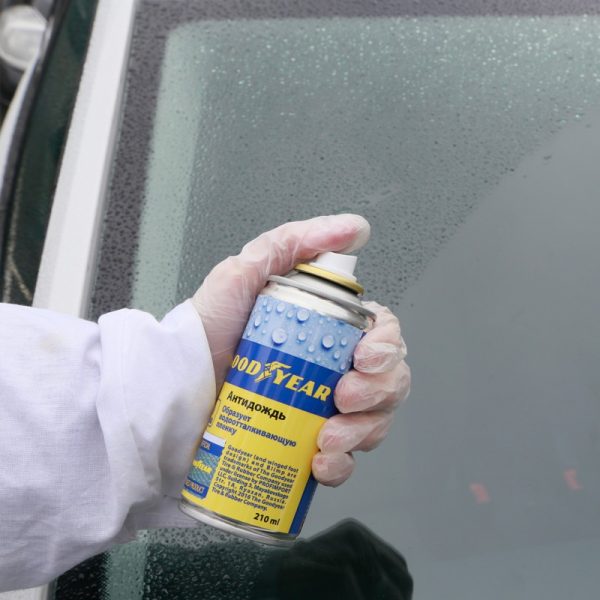 Spray products are the most popular, due to their practicality and availability.
Spray products are the most popular, due to their practicality and availability.
In addition to purchased polishes, you can make "anti-rain" at home. For these purposes, mainly used:
- paraffin;
- silicone oil;
- building sealant;
- fabric softener.
How to make "anti-rain" with your own hands
The recipe for a homemade "anti-rain" will differ depending on the chosen base. Therefore, the preparation of each of the compositions, its features and method of application should be considered separately.
On paraffin
The simplest agent that repels water from the glass surface can be prepared on the basis of paraffin (wax). To do this, you will need:
- paraffin candle 10 g;
- "White spirit" 100 g;
- non-woven napkin.
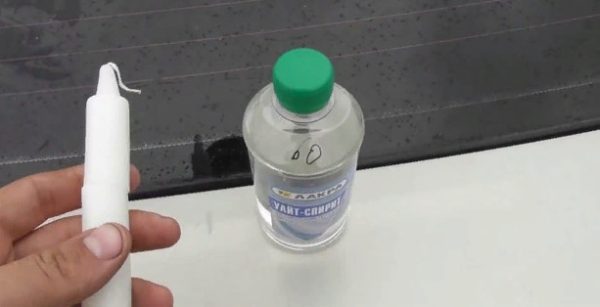

To prepare "anti-rain", perform the following steps:
- We rub the paraffin candle on a fine grater.

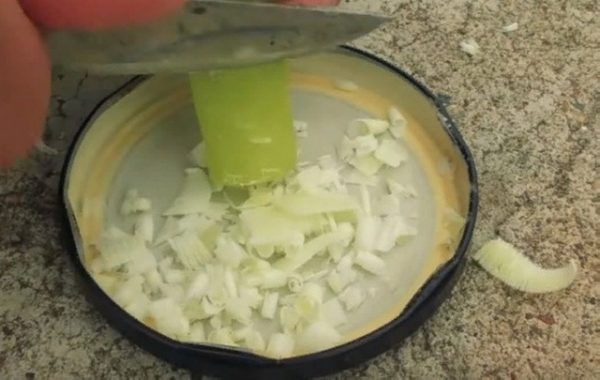 We rub the paraffin candle on a grater or chop with a knife
We rub the paraffin candle on a grater or chop with a knife - Pour paraffin into a suitable container and fill with solvent.

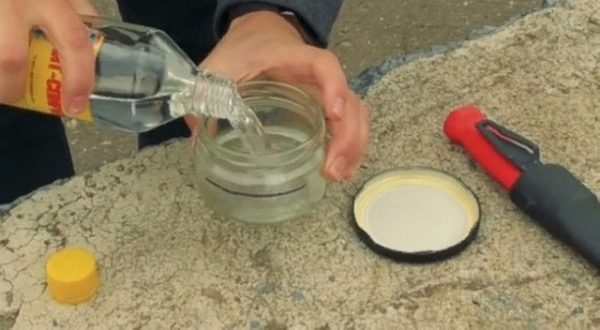 Add the solvent to the container with paraffin
Add the solvent to the container with paraffin - Stir the mixture, achieving complete dissolution of the chips.
- Apply the product to a clean and dry surface.
- We wait for a while, after which we wipe it with a clean rag.

 After processing, wipe the surface of the glass with a clean cloth.
After processing, wipe the surface of the glass with a clean cloth.
The application of such a composition does not damage the glass in any way. The positive aspects of the substance include ease of preparation and affordable cost. Among the shortcomings, it is worth highlighting the appearance of stains on the surface, which is especially noticeable in the dark. The duration of action of the described composition is about 2 months, which directly depends on the number of car washes and precipitation.
Video: "anti-rain" from paraffin


Watch this video on YouTube
On silicone oil
Silicone oil is an absolutely harmless agent that does not cause any harm to glass, plastic, rubber bands, body paintwork. The effect of the use of such a substance is quite long and is not inferior to expensive purchased "anti-rains". The cost of oil is about 45 rubles. for a bottle of 15 ml, which will be enough to process a car. We use the oil in this way:
- To treat the windshield, apply a few drops of oil to the rubber bands of the wipers and rub them with a cloth.
- We turn on the cleaners and wait until they rub the substance on the glass.
- To process other glasses, it is enough to apply a few drops of oil to the surface and rub them with a clean rag.
For application on glass, it is recommended to use PMS-100 or PMS-200 silicone oil.
Video: glass treatment with silicone oil


Watch this video on YouTube
On fabric softener
To prepare an “anti-rain” based on an air conditioner, you will need a conventional detergent used when washing clothes. For the purposes under consideration, it is recommended to use Lenore, since it is more effective than similar means. The list of necessary for the preparation of the solution consists of the following:
- 1 cap "Lenora";
- distilled water;
- empty bottle for mixing the mixture of 5 liters.
The preparation of the product is carried out in the following sequence:
- Pour Lenore into an empty container.

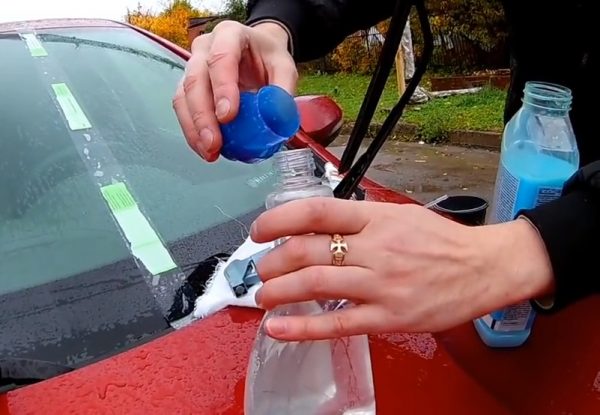 Pour rinse aid into an empty bottle
Pour rinse aid into an empty bottle - Add 3-4 liters of water and mix well.

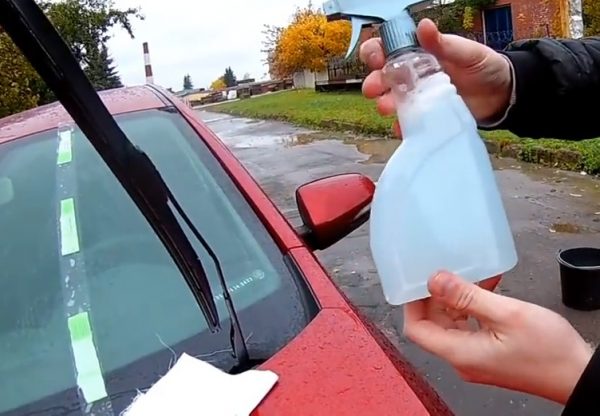 Add water to rinse aid and mix well.
Add water to rinse aid and mix well. - We clean the windshield washer reservoir and fill it with liquid.

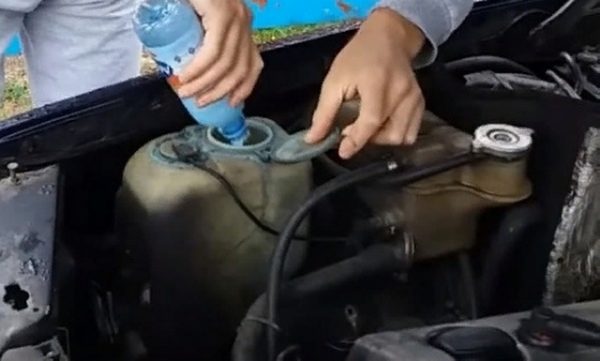 Pour the detergent into the washer reservoir
Pour the detergent into the washer reservoir - Spraying glass.
Video: using "anti-rain" from "Lenora"


Watch this video on YouTube
It is necessary to use the “anti-rain” based on rinse aid in the same way as a regular washer fluid, only not as often.
The advantage of the considered composition is a simple procedure for preparation and use. Among the disadvantages of "anti-rain" from the air conditioner, it is worth highlighting the appearance of a film on the glass, which in the daytime can impair visibility. To eliminate the appearance of the film, it is necessary to use high-quality wipers that will adhere well to the glass.
On sealant
Another tool that can be used to prepare a homemade "anti-rain" is building sealant. For this you will need:
- 50 g of White Spirit solvent;
- a teaspoon of building sealant;
- plastic bottle.
From the practice of motorists, it can be noted that the most common and effective is Moment neutral silicone sealant. The cooking process is as follows:
- Pour the solvent into the container.
- Add sealant.

 Add building sealant to the bottle
Add building sealant to the bottle - Stir the mixture.

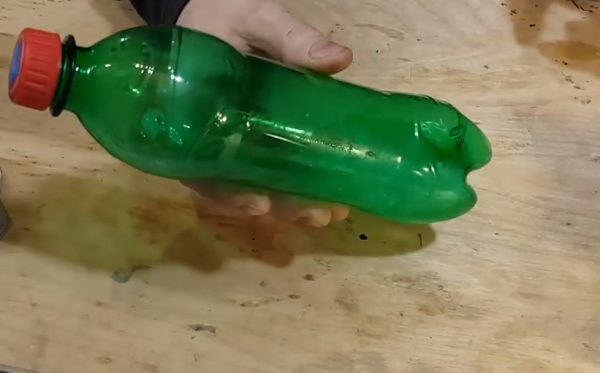 Mixing the solvent with the sealant
Mixing the solvent with the sealant - Apply to the surface.

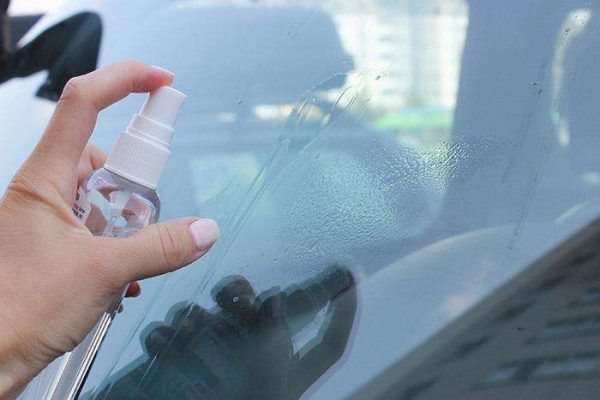 We apply "anti-rain" on the glass by spraying
We apply "anti-rain" on the glass by spraying
Video: homemade "anti-rain" from building sealant


Watch this video on YouTube
"Anti-rain" from sealant is most conveniently applied from a spray bottle. After spraying, wipe the surface with a clean, lint-free cloth. After such a tool, there are no stains or any traces left, while the glass is perfectly protected from dirt and water. Everyone can prepare such a composition due to the availability and low cost of the components. For example, the cost of a sealant starts at only 100 rubles.
The experience of car enthusiasts
I used High Gear, I liked the effect, but not for long, on average it was enough for a week in normal weather, in rainy weather for 3-4 days. On the side windows of my brother, it has been holding for half a year, the effect is gorgeously visible. I heard that RainX is for sale somewhere in METRO, I'm looking for it. In England, the guys only use it.
Manufacturer turtle, rubbed without plaque, enough for about 3 months. All glasses are rubbed in half an hour, a very convenient thing. Worth a penny, no cons found. There are left-wing anti-rains, but you get tired of applying them, you rub them, rub them, and the glass is in a whitish coating.
I apply the usual anti-rain from Turtle and from someone else. I apply it myself, the method is simple, but it also lasts a maximum-premaximum for a month - this is ideal, otherwise it’s good for 2 weeks, then the efficiency drops decently, but it’s done quickly: I washed the glass, applied it, rinsed it, wiped it off.
Turtle Wax is quite an anti-rain medicine - ours, cheap, cheerful, helps a little. Runway Rain - quite, they give at work. Aquapel - spoiled. Q2 View - very expensive, good, they used to give it at work, then they stopped.
Among motorists, self-preparation of “anti-rain” is quite popular. This is due to the low cost of the components and their effectiveness. In addition, special skills are not required to obtain one or another composition. Each car owner will be able to prepare such a tool, since this will require a minimum of time and financial costs.

